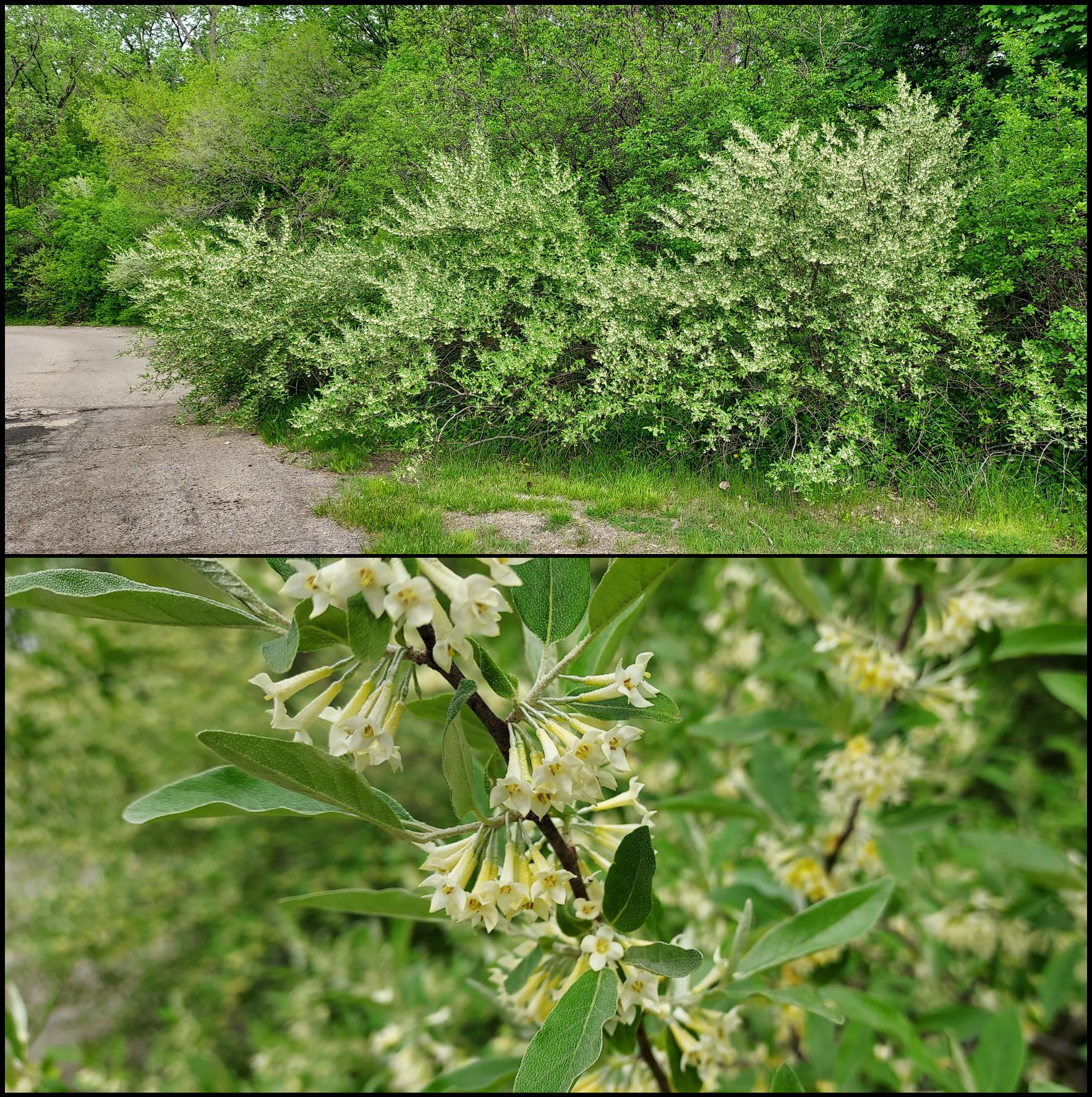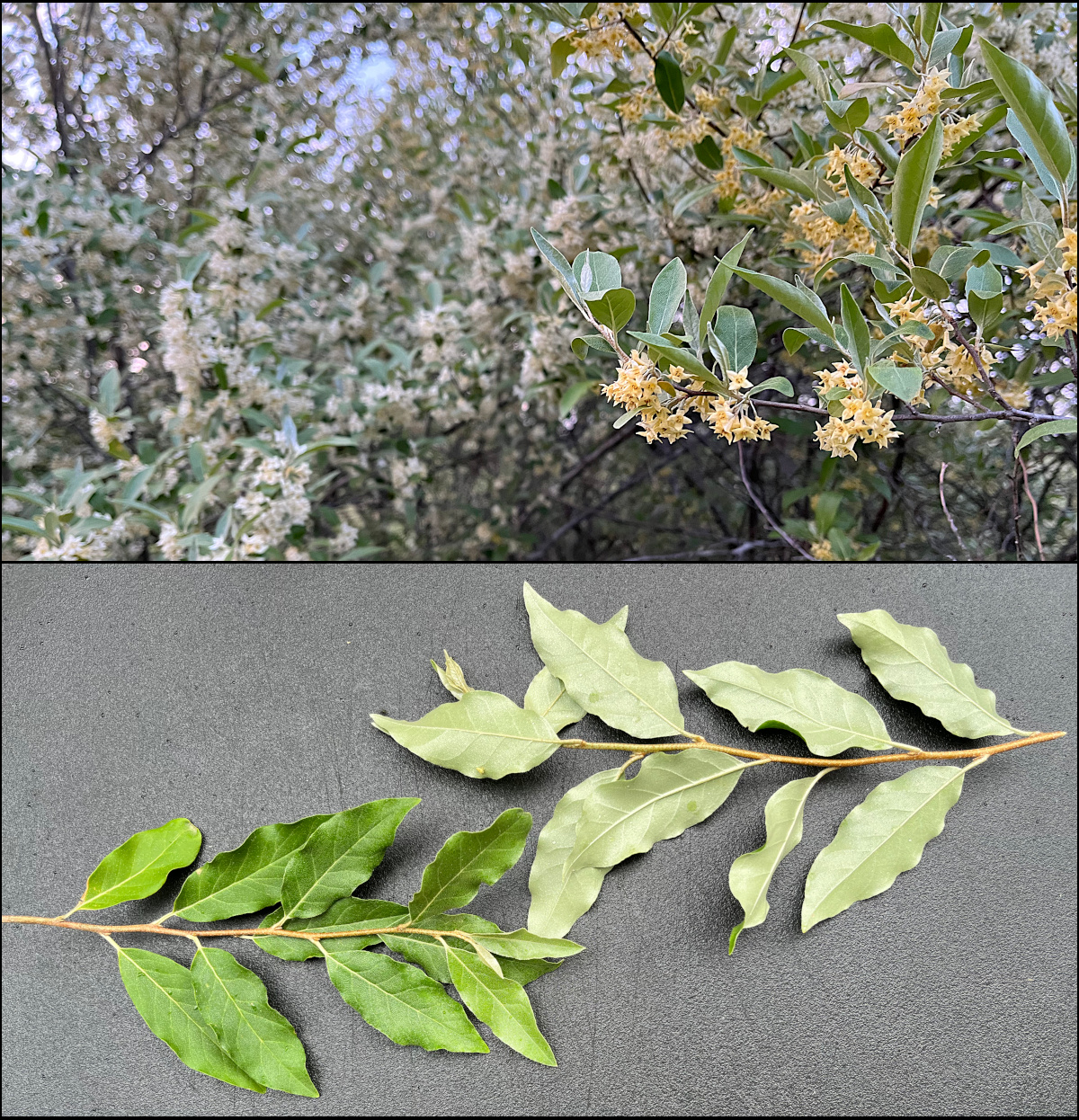Drive-by botany: Marsh marigold and autumn olive
Profiles of common Michigan roadside flora in late May 2023.

Authors’ note: Drive-by Botany is a continuing series that highlights flowering plants commonly seen from the road. As a service to new readers, we include the introduction with each article. If you're already familiar with the premise, feel free to skip down to the good stuff.
Has a patch of flowers ever caught your eye as you travelled down the road? It certainly happens to us all the time! As gardeners and naturalists, we're always interested increasing functional diversity in our gardens and landscapes, so we thought it would be fun to consider some of the roadside plants that we see every day. Each article in this series will feature two plant species that are currently blooming and frequently observed from the road. Our goal is to answer two simple questions:
- What are they?
- Would they make good garden plants?
As part of the process, we'll include some biological tidbits and a few useful characteristics for identification. Please note that some of the plants we feature are exotic invasive species; we'll be sure to include recommendations from land management professionals on how to manage them in your landscape.
May 2023 - week 21, 305 growing degree days (GDD) base 50, East Lansing, Michigan
Marsh marigold (Caltha palustris)
Synonyms: kingscup, cowslip
Marsh marigold is a perennial herbaceous plant belonging to the buttercup family (Ranunculaceae), a relatively small plant group with a wide range of distinctive features. While no specific trait definitively distinguishes a plant as a member of the Ranunculaceae family, taxonomists have identified several common characteristics shared by many species within the group. Generally, these plants bear complete flowers with radial symmetry, featuring numerous sepals and petals arranged in multiple whorls. Some species possess modified petals called nectaries, which produce nectar to attract pollinators. Several species lack petals altogether. Sepals also display variability across different species, appearing in various colors, including green, and sometimes resembling petals. Similarly, the leaves of Ranunculaceae plants exhibit significant diversity. They may be either single or compound (even on the same individual!), typically displaying serrated or lobed margins, and are arranged either alternately or oppositely along the stem.
Quick definition: A complete flower is one that has both female and male reproductive parts.
While the majority of plants in the Ranunculaceae are herbaceous, there are also notable instances of woody vines and shrubs. As one might expect, numerous groups within the buttercup family possess significant ornamental appeal, including Delphinium, Clematis and Ranunculus.
Description
Flowers: In wetlands across North America, marsh marigolds are a true springtime delight. Their bright yellow flowers range from 0.75 – 2.25 inches in diameter and rest atop flower stalks that can grow up to 30 inches tall (Photo 2). Like many in the buttercup family, Caltha palustris flowers contain numerous stamens (male reproductive structures) that produce an abundance of pollen. Another distinctive trait of the Ranunculaceae is the frequent absence or reduction of petals, with the showy elements of the flowers actually being the sepals. This phenomenon is referred to as petaloidy. In the case of Caltha palustris, the flowers lack both petals and nectaries. Instead, the sepals take on a petal-like appearance, enhancing the flower's vibrant display. This unique trait exemplifies the family's tendency towards modified sepals, which play a crucial role in attracting pollinators and contributing to the overall visual charm of the flowers.

Leaves: Caltha palustris has simple leaves that are typically heart-shaped with smooth or slightly toothed margins (Photo 2). The plant first forms a basal rosette of leaves in the spring. As the season progresses, it produces additional leaves in an alternate arrangement up the flowering stems.
Seeds/fruit: Each marsh marigold flower gives rise to a fruiting structure called an achene, which is formed in a radially symmetrical manner and consists of multiple sub-compartments referred to as follicles (Photo 2). As the achene matures and dries, the upper part of each follicle opens up, revealing a cup-shaped compartment containing seven to 20 small, brown-black seeds. The dispersal of these seeds is primarily aided by wind or rain.
Quick definition: An achene is a type of dry fruit with a hardened wall that contains a single seed. For comparison, sunflowers also produce achenes -- the outer shell is actually the hardened fruit wall that we break open in order to get to the seed inside.
Stem: Flowering stems are smooth and hollow, bearing basal leaves, and often growing up to 2.5 feet tall.
Distribution: Caltha palustris thrives in wet habitats, particularly low-lying areas such as swamps, fens, wet meadows and stream banks. This species is typically found in the shallow, cool water of groundwater seeps. Its distribution in North America spans across Canada and encompasses the entire northeast quadrant and the western coast of the United States.
Blooming period: This species typically blooms between late April and June in Michigan.
Native status: The species is native to wetland areas in temperate regions of the Northern Hemisphere, including Michigan.
Garden uses: Marsh marigold is an ideal choice for both rain gardens and water gardens. With its vibrant yellow flowers, handsome foliage and (relatively) tidy growth habit, it could serve quite well as a border planting. Due to its requirement for moist habitats, Caltha palustris can be useful in wetland restoration projects when planted in areas that require stabilization, such as wet meadows or along the banks of streams and ponds.
Jeremy's gardening tip: Consider pairing it with skunk cabbage to give your rain garden a decidedly natural appearance (Photo 1).
Similar species: Lesser celandine (Ficaria verna)
Autumn olive (Elaeagnus umbellata)
Synonyms: Japanese silverberry, spreading oleaster

Autumn olive is a large perennial shrub that can readily colonize an area through prolific reseeding and suckering. It is a member of the Elaeagnaceae (Oleaster) family, of which many are tolerant of poor and high salinity soils. While it does share a similar common name, it is not related to edible olives, which belong to the Oleaceae family. Its closely related cousin, Russian olive (Elaeagnus angustifolia), can be found in Michigan, growing as a small tree.
Description
Flowers: Elaeagnus umbellata flowers are buttery yellow or cream-colored and usually appear from mid-May to early June in Michigan (Photos 3 and 4). Although individually small and unassuming, these trumpet-shaped blossoms are produced in large numbers and arranged in clusters of up to eight blooms. The sweet and delightful fragrance of the flowers fills the air, carrying its captivating scent across considerable distances when the wind blows in the right direction.

Leaves: Leaves on this plant are long and narrow with smooth, rippled margins. Their undersides have a scaly texture with a characteristic silver glitter-like appearance when viewed up close (Photo 4). Autumn olive leaves are arranged alternately along the stem and range from 2-4 inches in length.
Seeds/fruit: Unripened fruit may have a green appearance with a silvery coating. The ripened fruit is reminiscent of miniature cherries with rough tan spots on their surface. Fruits are typically smaller than a pea and contain an individual seed. They are often numerous when shrubs are found growing in full sun and are loved by birds.
Size: Elaeagnus umbellata typically grows as a multi-stemmed shrub with a rounded to spreading growth habit. It can reach a height of up to 20 feet with a similar spread (Photo 3).
Distribution: Like many invasive species, autumn olive is highly tolerant of poor site conditions. This allows it to outcompete native plants and quickly fill in disturbed sites. It thrives in abandoned fields and construction sites, as well as roadsides. Wildlife happily seek it out as a food source, facilitating its dispersal throughout the landscape. While it prefers full sun, it can adapt to shaded areas, albeit with reduced fruit production. Its adaptations don't stop there. Much like legumes, autumn olive hosts nitrogen-fixing bacteria in its roots, allowing it to thrive in low-nutrient soils where other plants cannot.
Fun fact: Autumn olive is polygamodioecious. Say that three times fast! This means that male and female flowers occur on different plants…except when they don’t. Occasionally, male flowers will grow on female plants, and male plants will grow female flowers.
Native status: Exotic/introduced. This species is not native to the United States. The first established wild samples were collected in 1939, making it a long-established exotic weed.
Garden uses: Autumn olive is a restricted plant species in Michigan. It was introduced to the United States in 1830 for use as a windbreak and erosion control and was planted widely in Michigan in the 1950s and 1960s for soil conservation and wildlife habitat. In its native range of eastern Asia, it is an important food source for wildlife. However, in the United States, it aggressively outcompetes native plants, reducing local biodiversity. Once established in a landscape, it can be tough to eradicate. Simply cutting shrubs to the ground will result in vigorous suckering from the stump and roots.
One of the most effective methods of controlling autumn olive is to sever the woody stems near the base of the plant and then apply an herbicide to the stump immediately. Cut-stump herbicide applications are a common practice employed by land managers and ecological restoration specialists. For those that want to learn more, the Michigan Department of Natural Resources has created an excellent bulletin that outlines best control practices for autumn olive. As always, follow the label when applying any pesticide.
Similar species: Russian olive (Elaeagnus angustifolia) resembles autumn olive in appearance due to their close relation. Russian olive foliage has a grayer cast to it because both sides of the leaves have a gray or silver coloration. In contrast, autumn olive leaves only have silvery undersides. Neither plant is desirable due to their invasiveness and painful thorns. Soapberry (Shepherdia canadensis) looks similar to autumn olive but has opposite leaves instead of alternate.
Want more Drive-by Botany? Check out some of our previous roadside adventures!
- Purple deadnettle and Morrow’s honeysuckle
- Yellow rocket and Dame’s rocket
- Golden Alexanders and Arrowwood viburnum
Questions? Feel free to contact Jeremy Jubenville or Barslund Judd with the MSU Extension landscape team.
Thank you to Tyler Bassett from the Michigan Natural Features Inventory for his review of this article.
Resources:
- Michigan Flora (2001) – E. Voss



 Print
Print Email
Email





